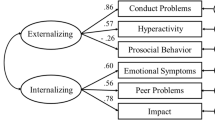Abstract
Associations between maternal nausea during pregnancy and child behavioral outcomes were investigated in a large birth cohort. Generally, 2nd- and 3rd-trimester nausea were more predictive of child outcomes than 1st-trimester nausea. Children whose mothers reported nausea in middle or late pregnancy had lower sensory thresholds and higher levels of activity and emotional intensity in infancy and were reported to be lower in task persistence at age 5. At age 12, these children were viewed by teachers as more careless with their school work and as having more attentional and learning problems.
Similar content being viewed by others
REFERENCES
Adell, T. L., & Riely, C. (1992). Hyperemesis gravidarum. Gastroenterology Clinics of North America, 21, 835-849.
Carey, W. (1970). A simplified method for measuring infant temperament. Journal of Pediatrics, 77, 188.
Eisenberg, N., & Fabes, R. A. (1992). Emotion and its regulation in early development. New Directions in Child Development, 55. San Francisco: Jossey-Bass.
Gillis, F. H., Leviton, A., & Dooling, E.C. (1983). The developing human brain. London: Wright.
Gray, J. (1987). The psychology of fear and stress. New York: Cambridge University Press.
Gross, S., Librach, C., & Cecutti, A. (1989). Maternal weight loss associated with hyperemesis gravidarum: A predictor of fetal outcome. American Journal of Obstetrical Gynecology, 160, 906.
Heinonen, O. P., Slone, D., & Shapiro, S. (1977). Birth defects and drugs in pregnancy. Littleton, MA: Publishing Science Group.
Hod, M., Orvieto, R., Kaplan, B., Friedman, S., & Ovadia, J. (1994). Hyperemesis gravidarum: A review. Journal of Reproductive Medicine, 39, 605-612.
Iatrakis, G. M. et al., (1988). Vomiting and nausea in the first 12 weeks of pregnancy. Psychotherapeutic and Psychosomatic Medicine, 49, 22.
Kagan, J. (1994). Galen's prophecy: Temperament and human nature. New York: Basic books.
Lambert, N., & Hartsough, C. (1973). Scaling behavioral attributes of children using multiple teacher judgments of pupil characteristics. Educational and Psychological Measurement, 33, 859-874.
Machon, R. A., Huttunen, M. O., & Mednick, S. A. (1997). Adult major affective disorder after prenatal exposure to an influenza epidemic. Archives of General Psychiatry, 54, 322-328.
Martin, R. P., Noyes, J., Wisenbaker, J., & Huttunen, M. O. (in press). Prediction of early childhood negative emotionality and inhibition from maternal distress during pregnancy. Merrill Palmer Quarterly.
Martin, R. P., Wisenbaker, J., Baker, J., & Huttunen, M. (1997). Gender differences of temperament at six months and five years. Infant Behavior and Development, 20, 339-347.
Mednick, S., & Huttunen, M. O. (1999). From the wings of drosophilia to the brains of mental patients. Unpublished manuscript.
Norman, M. G., & Armstrong, D. D. (1998). Disturbances of brain development. In E. E. Coffey & R. A. Brumback (Eds.), Textbook of pediatric neuropsychiatry. Washington, DC: American Psychiatric Press.
Rothbart, M. K., & Bates, J. (1997). Temperament. In N. Eisenberg (Ed.) & W. Damon (Series Ed.), Handbook of child psychology: Vol. 3. Social, emotional, and personality development (5th ed., pp. 105-176). New York: Wiley.
Schulze, K. F., Kashyap, S., Sahni, R., Fifer, W. P., & Meyers, M. M. (1990). Nutrition and behavioral states in the developing human infant. In J. P. Lecanuet, W. P. Fifer, N. A. Krasnegor, & W. P. Smotherman (Eds.), Fetal development: A psychobiological perspective (pp. 149-168). Hillsdale, NJ: Erlbaum.
Tanner, J. M. (1990). Fetus into man: Physical growth from conception to maturity. Cambridge, MA: Harvard University Press.
Thomas, A., & Chess, S. (1977). Temperament and development. New York: Basic Books.
Author information
Authors and Affiliations
Corresponding author
Rights and permissions
About this article
Cite this article
Martin, R.P., Wisenbaker, J. & Huttunen, M.O. Nausea During Pregnancy: Relation to Early Childhood Temperament and Behavior Problems at Twelve Years. J Abnorm Child Psychol 27, 323–329 (1999). https://doi.org/10.1023/A:1022662726587
Issue Date:
DOI: https://doi.org/10.1023/A:1022662726587




